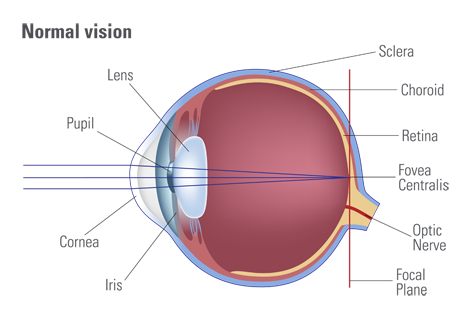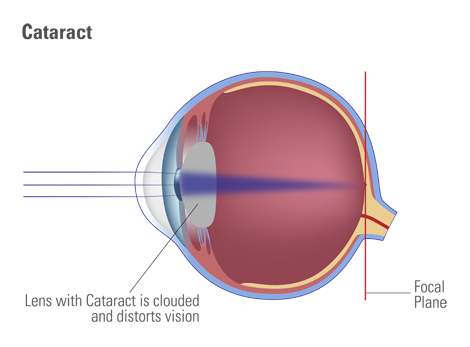
What is a cataract?
|
A cataract occurs when the eye's natural lens is clouded. When the lens becomes opaque, vision is reduced and colors appear faded. People with cataract often experience difficulty seeing in low light conditions or in situations with glare. The following illustration shows how cataract might affect your vision. |
|
 |
 |
| Figure 1: Normal vision | Figure 2: Vision affected by cataract |
What are the causes for cataract?Most cataracts occur due to the natural aging process of the lens, typically after age 60. The normally clear lens will progressively become cloudy due to a build-up of protein molecules. Since this process is very slow many people will not notice that a cataract has been developing for several months or even years. Other causes of cataract may include physical trauma to the eye, or in rare cases, cataract can occur in babies or children though the causes are not well understood. As the lens becomes increasingly cloudy, an untreated cataract can leads to blindness. |
|
 |
 |
| Figure 3: Schematic representation of normal vision | Figure 4: Schematic representation of cataract affected vision |
How can it be treated?Currently there is no pharmacological way to treat a cataract. Once the cataract has progressed to the point where vision is impaired, surgery is recommended. Fortunately, with the advent of modern technology cataracts are routinely treated and vision restored in tens of thousands of patients every year. The operation is safe and effective and involves exchanging the cloudy lens for a clear artificial lens through a surgical procedure that lasts less than 30 minutes. The latest innovation is the use of a femtosecond laser. This high precision instrument enhances the reliability of surgical outcomes. Learn more about Z-Cataract here. Most cataract surgery is performed on an outpatient basis and in rare cases patients may stay one night in the hospital. After receiving the treatment, many patients report how clear and colorful the world looks again. Another advantage to surgery is that with lens replacement, nearsightedness can be fixed by implanting perfect lens power for the patient. If standard artificial lenses are used, however, reading glasses may still be required. Your ophthalmologist will speak with you about what the best options may be for your particular situation. |
|

YOUR VISION |
Z-CATARACT
|
FIND A DOCTOR |
FOR PROFESSIONALS |
Important Safety Information
Cataract and lens surgery is one of the most frequently performed and safest operations in medicine today. However, make sure to discuss your medical history and medication use with your doctor prior to scheduling a surgery. The use of cardiac or blood thinning medications such as Warfarin should be discussed with your doctor. Complications from cataract surgery can occur as surgeries of any kind will carry some risk. While femto cataract surgery is considered a safe and effective treatment option for most people, your doctor may suggest an alternative treatment that best fits your individual needs.
Ziemer FEMTO LDV lasers are prescription medical devices that can only be used by accredited eye care professionals for cataract and other approved surgical procedures. Only a trained eye care professional can determine if a FEMTO LDV laser procedure is appropriate for your condition. Talk to your doctor if you have a family history of keratoconus, glaucoma, other eye-related diseases, diabetes, a history of herpes simplex or herpes zoster keratitis, retinal detachment, severe allergies or have had changes in your vision over the past year.
Results may vary for each individual patient due to the surgical operation and the type and placement of artificial lens. Speak with your doctor about which artificial lens may be right for you. In order to reduce post-operation complications, make sure to follow your doctors instructions for eye care. If you your surgeon has prescribed drugs to take before or after surgery, follow the dosage instructions. After surgery, avoid risky activities such as sports, face painting, heavy lifting, contact with water etc.











